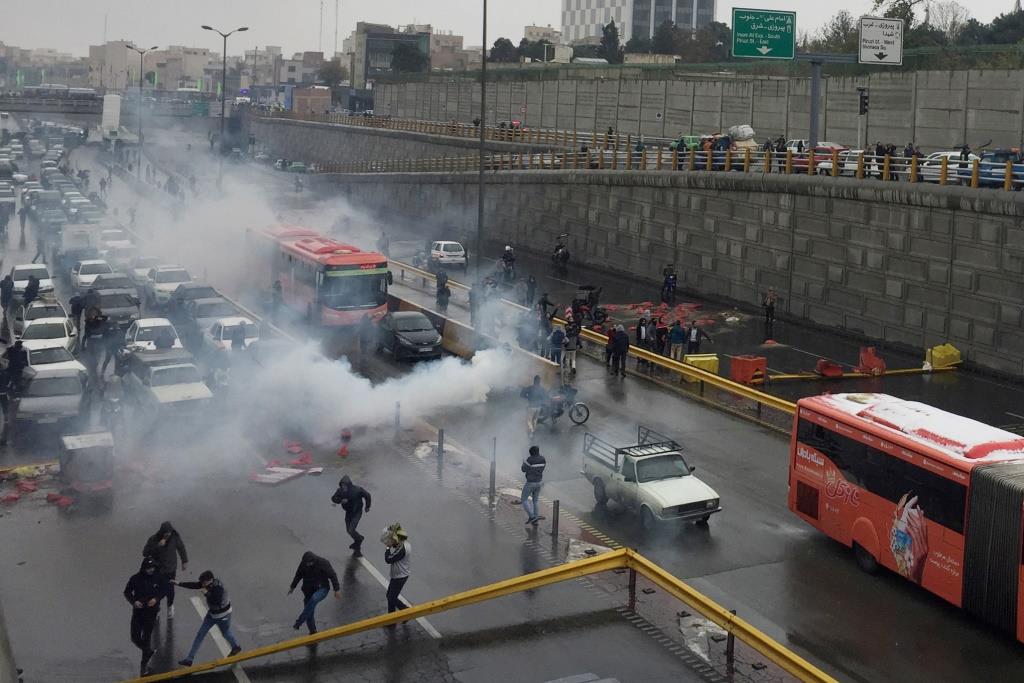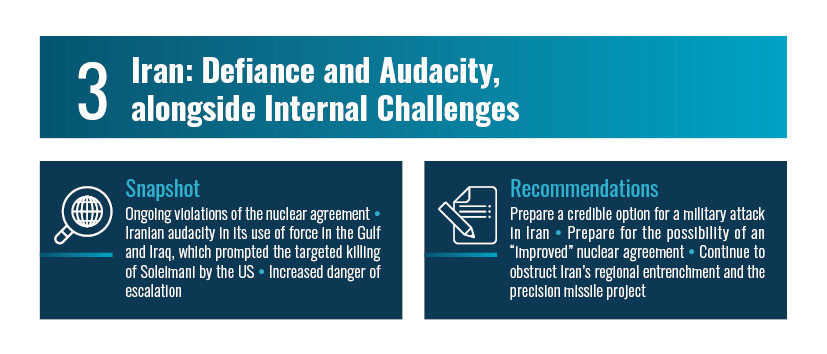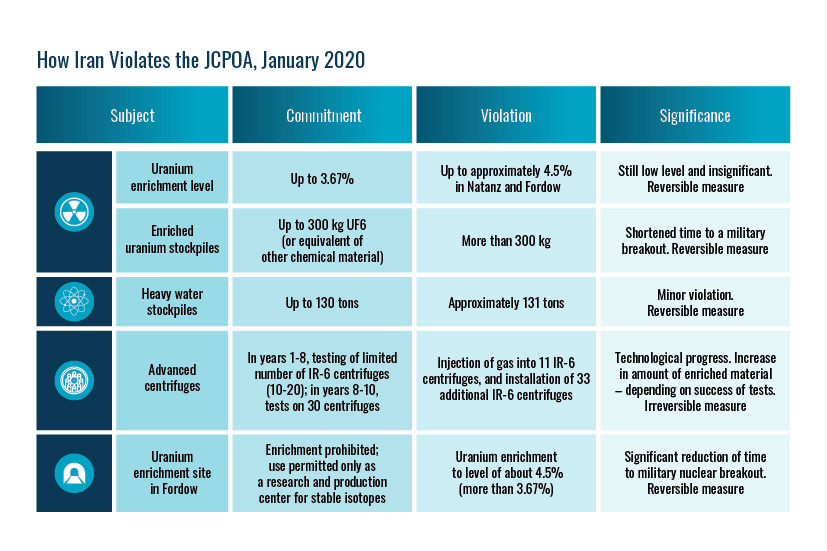Publications
Strategic Survey for Israel 2019-2020, The Institute for National Security Studies, January 2020
![Khamenei.ir [CC BY 4.0]](https://www.inss.org.il/wp-content/uploads/2020/01/Qasem_Soleimani_received_Zolfaghar_Order_from_Ali_Khamenei_1.jpg)
2019 was marked by Iranian audacity on the nuclear issue and in regional activity, and over the year the confrontation with the United States intensified. The sanctions that the American administration imposed on Iran after withdrawing from the nuclear deal in May 2018, and especially the cancellation of the waiver on importing oil from Iran in November 2018, have created severe challenges for the Iranian economy. Iran abided by the commitments stipulated in the nuclear agreement for a year, in the hope of dividing Europe from the Trump administration and receiving adequate economic compensation from the other partners to the agreement. However, Europe’s lack of success in creating an alternative mechanism for conducting transactions with Iran and a heightened US “maximum pressure” policy, along with public criticism of Iran’s regional activity, led to changes in Tehran’s policy. The first sign was Iran’s failure to adhere to the restrictions on its nuclear program imposed by the agreement. In addition, Iran undertook provocative military activity in the Middle East against United States allies, marked especially by the attack on the oil facilities in Saudi Arabia, and against the United States itself, which began with shooting down the American UAV and led to the attack on American citizens (including one fatality) and charging the embassy in Iraq, which prompted the string of responses that led to the targeted killing of Soleimani.
The Nuclear Program
In the face of the “maximum pressure” policy that the United states has adopted since May 2018, which in practice has mainly taken the form of economic measures (sanctions) and political measures (diplomatic pressure), Iran employs a policy of “maximum resistance,” which reflects its assessment that it can withstand the economic toll taken by the sanctions. In response to President Trump, who repeatedly emphasizes his desire for negotiations that would lead to a new agreement, the Iranian leadership insists that it will not return to negotiations without the compensation it was entitled to according to the agreement, and even then would only do so within the multilateral framework of the P5+1.
Concurrently, Iran is working to advance its nuclear program – with steps that began in limited and measured fashion, but have intensified with time – and is incurring additional risks while pursuing military action in the Gulf. The goal is to harm Washington’s principal allies in the region and the global oil market, and illustrate the costs of the American policy toward Iran. On the other hand, Iran continues to maintain its connections with European states, while emphasizing its willingness to return to the nuclear agreement if the sanctions are lifted. Thus, it leaves open the possibility of continuing the diplomatic talks to foster ties with the United States. Relations with Russia are also maintained and strengthened based on shared interests in Syria that oppose those of the United States; in this sense, Israeli hopes of driving a wedge between Moscow and Tehran have not borne fruit, despite the existing gaps between them.
Therefore, on the nuclear issue, the sides have reached a dead end: the United States has no long term strategy other than continuing the economic sanctions as a tool for changing Iranian policy (without the intention to change the current regime) and bringing Iran back to the negotiating table; the Europeans are worried about escalation and prefer to define Iran’s defiant actions as minor; and the Iranians themselves do not intend to return to negotiations if their demands regarding the sanctions are not met, and they continue to move forward with the nuclear project.
Consequently, 2020 will likely be marked by continued Iranian challenges that will include escalating steps in the nuclear program. Prospects for renewed negotiations between Iran and the United States, though slim, largely depend on President Trump’s willingness to relax the sanctions. The main significance of this for Israel in 2020 is Iran’s continued uranium enrichment and accumulation of fissile material (low level at this stage), continued progress on advanced centrifuges, possible escalatory actions in relation to enrichment levels, and perhaps even a reduction in IAEA inspection arrangements. This situation would shorten the amount of time needed to progress toward nuclear weapons, if Iran decides to do so.
Regional Activity
In 2019, Iran continued its military buildup in Syria, Iraq, Lebanon, and Yemen, in order to deepen its influence, reduce American influence, and establish bases for potential activity to harm Israel and Saudi Arabia as part of creating deterrence. For this activity, Iran depends on local elements that enable its freedom of action (not only military) – first and foremost Hezbollah in Lebanon and the Syrian regime, as well as pro-Iranian Shiite militias in Iraq and Lebanon and the Houthis in Yemen. In the Palestinian arena too, Iranian support for Islamic Jihad and Hamas continues, manifested in funding and in technological knowledge for rocket and missile production.
Iraq is a strategic asset for Tehran – given its long shared border with Iran, its position as a land and air bridge to Syria and Lebanon, the Shiite holy sites in Najaf and Karbala, and the historic connections between parts of the Shiite community and groups in Iran. This background in part drives Iran’s desire to continue to undermine the American influence in Iraq and end the American presence there. However, increasing public criticism of the Iraqi government over its identification with Iran has sparked unrest that threatens to harm Tehran’s achievements, which are based on special efforts to create economic, cultural, religious, and security influence in Iraq. The anti-American sentiments that infuse the protests in Iraq and the danger that these protests pose to Iranian interests strengthen the resolve of Tehran and the Shiite militias to bring these protests to an end.
The killing of Soleimani will not prompt any substantive change in Iran’s overall regional strategy, but it does challenge Tehran’s ability to achieve its objectives. Consequently, Iran and the United States are weighing their next steps. Iran’s dilemma lies between the need to respond forcefully (directly or through its proxies) against American targets and the fear of a powerful American counter-response. Therefore, action against United States allies in the region is also possible.
Syria has become a focus of unusual Iranian military activity, against the backdrop of the war that threatened to eliminate the regime of Bashar al-Assad, Iran’s important ally. The Iranian presence has created severe friction with Israel, which has increased its military activity to undermine Iran’s military buildup. The Syrian theater will continue to have the potential for escalation in the conflict between Israel and Iran, which could expand even though neither side is interested in all-out war. In parallel, Iran is investing in expanding its areas of cooperation with Syria. Alongside the continued military cooperation and signed military agreements, including the operation of parts of the Latakia port as well as research and development projects underway on Syrian soil with the assistance of the Syrian military industry, there is an effort to deepen involvement in economic, educational, and cultural matters.
Iran likewise saw achievements in Yemen: the Houthis’ victories on the ground; the reduction in UAE military involvement, leading to friction with Saudi Arabia; and the pressure on Saudi Arabia itself, especially in the US Congress, against the backdrop of human rights violations in the campaign in Yemen. The Iranians in effect have become the patrons of a future agreement in Yemen (a process that the UN is involved in as well) by creating a "diplomatic framework” for the Houthis. This agreement will ensure the status of the Houthis themselves, and through them, Iranian influence.
For Israel, the first significant element is that Iran continues to maintain its assets in the region and has even scored several achievements, despite difficulties that have arisen in Iraq and Lebanon and in development of its precision missile project, along with the post-Soleimani challenge. Iran plans to remain in Syria, and is building military, political, economic, and social infrastructure that will ensure its long term influence in Syria. It has also succeeded in forging cooperation with Russia in the Syrian space, despite the differences of opinion and the competition between them for influence in the arena.
The second significant element is that Israel’s toolbox is based mainly on kinetic activity, and is limited to Iran’s military buildup and the dissemination of knowledge, technology, and weapons to the various theaters (Syria, Iraq, Lebanon, Yemen, and the Gaza Strip). Israel is also working in the diplomatic sphere to tarnish Iran’s image and reduce its freedom of operation, but this activity does not address the soft power aspects and civilian/economic components through which Iran seeks to enhance its influence. Rather, Israel’s policy is primarily reactive in the face of Iranian policy and activity.

The Internal Arena
Over the past year, the Iranian regime seems to have been successful in stabilizing the socioeconomic arena. Alongside the continued poor economic indicators in the fields of inflation and unemployment, a high negative growth rate, and the collapse of its currency in the second half of 2018 and early 2019, the Iranian economy appears to be stabilizing and adapting to the sanctions regime. The International Monetary Fund estimates that inflation in Iran will begin to decline starting in 2020, and real growth, even if minimal, will begin. However, these macroeconomic figures do not improve the lives of citizens who took part in large scale and violent public protests in November 2019 (at some 150 locations throughout Iran), which focused on economic issues and antipathy toward the regime. As in the past, this time too the regime succeeded in suppressing the protests, using repressive measures and taking a heavy toll in lives (with hundreds killed) and making extensive arrests.
The past year has also been characterized by the strengthening of the conservative camp, led by Supreme Leader Ali Khamenei, who made a series of important appointments to reinforce the conservative control of the state. The most prominent among them was the appointment of radical cleric Ebrahim Raisi as Chief Justice (March 2019), in a step that some see as signaling the potential future successor of the Supreme Leader. In addition, the radical Hossein Salami was appointed Commander of the Revolutionary Guards, and conservative figures were appointed as heads of parliamentary committees. All of these steps are a precursor to the parliamentary elections in February 2020 and the presidential elections in 2021, as well as groundwork for the day after the current Supreme Leader. In effect, the appointments weaken the more pragmatic camp, whose representatives include President Rouhani and Foreign Minister Zarif, who are forced to toe the line with respect to the strict policy led by the Supreme Leader.
The Main Challenges for Israel
On the eve of 2020, the overall balance scale for Iran is a mix, but with achievements outweighing failures. Iran displays greater confidence in exerting its power in the regional arena and even against the United States; this stance will be tested following the killing of Soleimani. When it comes to the nuclear issue, Iran does not feel isolated and even believes that it has succeeded in isolating the United States. It assesses that it will be able to cope with its economic distress and the continued sanctions, while the United States is close to exhausting the stock of sanctions; it is advancing the nuclear program and accumulating bargaining chips for the future.
All of these underscore the failure of Western policy, which was based on inflicting economic damage that would create unrest among the Iranian public and in turn influence the policy of the regime.
The main challenge for Israel vis-à-vis Iran is to formulate a strategy that will allow the use of force in various theaters and on different levels, without escalating into a broad conflict. In tandem, Israel must build a credible option for the use of direct force in Iran and formulate understandings with Washington regarding three scenarios that are problematic for Israel.
* The first is negotiations between the United States and Iran, which could provide Tehran with the right to enrich uranium, without any concession in return regarding its surface-to-surface missiles and regional activity.
* The second is escalation between Israel and Iran.
* The third is Iran’s progress in its nuclear program while it continues to accumulate fissile material and reach higher enrichment levels, which would lead to a significant change in the time required for a potential breakout to nuclear weapons.
On these three central issues, there is a gap between Israel’s interests and those of the United States, and specifically those of President Trump.




